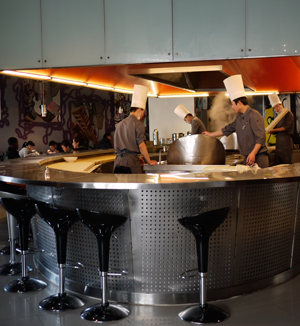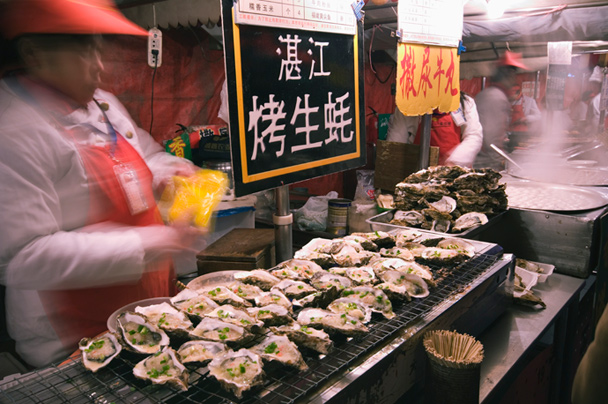It was with some trepidation that I approached this assignment. Don't get me wrong—what writer doesn't love to get paid to go on an eating spree in one of her favorite cities? Beijing now offers an eclectic embarrassment of riches as far as great restaurants go, yet navigating around this massive metropolis, especially with its unbelievable traffic delays, presents a huge challenge. The extensive subway system, completed over the last decade, is a lifesaver, and thanks to a miracle during my recent stay—a respite from the dense pollution that normally cloaks the city—I could walk off my meals and try as many places as humanly possible.
To say that the restaurant scene has blossomed—especially since my first visit in 1979, early in the post-Mao era—is an understatement. Beijing is having a big-money moment, as exemplified by the latest culinary trend: High-end restaurants that specialize in regional cuisine are sparing no expense to fly in freshly picked fruit and vegetables, fish, meats, and other specialty foods daily from their particular province of origin.
With each trip I make (the count now hovers between 30 and 40), I never cease to marvel at the extraordinary selection of eateries in the capital. For any journalist on this type of assignment, the joy is to discover the insider, not-yet-on-the radar establishments. And this last visit yielded some very exciting new finds along with some great meals at a few spots you may already have your eye on.
Jet-lagged or not, I made sure to rise early to sample the Chinese breakfast at Made in China, the renowned restaurant at the centrally located Grand Hyatt Hotel. I am a huge fan of northern-style Chinese breakfasts, which often consist of dou jiang (soybean milk seasoned with sugar or savory flavorings such as minced scallions, ginger, and hot chile paste) and yu tiao (fried Chinese crullers) stuffed into shao bing (flaky sesame seed flatbreads), as well as various dumplings, so I was thrilled that the Hyatt had begun offering a fixed-price buffet. At about $30, the tab is well worth it for an endless array of traditional Beijing treats, among them sweet and savory steamed, pan-fried, and deep-fried dumplings; six different types of congee, including sweet potato and assorted grains such as black rice, corn flour, and sorghum; multiple soups; spring rolls; thin pancakes stuffed with crisp Peking duck skin and tender meat; and a number of other hard-to-find classics.
Many argue—and I agree—that if you are traveling to Beijing, there are certain local specialties that are a must to try, especially dumplings and noodles. So if you haven't gotten your fill of dumplings at the Hyatt for breakfast, don't miss lunching at Xian Lao Man, which, again, specializes in northern-style food. A favorite of Chinese art curator Nancy Berliner of Massachusetts' Peabody Essex Museum, it is a no-frills local hangout, and though we didn't encounter any English speakers on staff, there's a Chinglish menu and the service was very friendly. The pan-fried dumplings, or guo tieh, were delicious and simply but elegantly presented; of the many selections, we opted for a filling of fresh dill and egg. Other not-to-be missed dishes include braised bamboo shoots and crisp, deep-fried mildly hot green chile peppers.

For a more elegant, contemporary setting and an outstanding selection of homemade noodles, visit the Noodle Loft for lunch. This spot features the cuisine of Shanxi, a province to the southwest of Beijing, and the draw are the oodles of noodles, many of which are made by hand. Grab a seat at the bar, where you can watch the chefs preparing noodles from scratch. Make sure to try the yi ba zhua (fried wheat cakes with garlic chives) and the qiao mian mao erduo (cat's ear–shaped noodles with ground meat sauce).
It bears mentioning that a superb lunch—albeit a Western one—can be had at Maison Boulud, a 2008 addition to the mushrooming global empire of Daniel Boulud. Every one of my invaluable ad hoc consultants to this article—my scouting retinue of friends and colleagues—insisted I visit this stately and tastefully decorated restaurant to sample the $25 fixed-price lunch, an incredible steal. The lavish three-course meal, served in the equally posh surroundings of the former United States Embassy, did not disappoint. I couldn't resist ordering one of Boulud's DB burgers—sumptuous enough to share, with its foie gras and boneless short rib center. My companion happily devoured half along with his impeccably prepared roast suckling pig and smoky white-bean minestrone soup, plus a generous portion of my endive and pear salad, all made with locally grown greens and fruit. And then there was dessert.…
A great stop at any time of day or evening is Wangfujing Snack Street, where natives and foreigners alike enjoy some of Beijing's best street food. Cooks deftly toss ingredients on their portable stoves, and the sound of hawkers calling out their offerings is deafening. At dusk, purveyors set up little tables covered by red-and-white-striped canopies that line the street as far as the eye can see. Try the red-cooked meat, grilled lamb or beef skewers, or all manner of exotica, from scorpions to pickled, salted, fermented vegetables; numerous pan-fried and steamed dumplings; and teas. Stalls stay open from 10 a.m. to 10 p.m., so come for an afternoon snack, a meal, or just to explore and take photos.
What would dinnertime in Beijing be without a taste of one of the city's most famous specialties, Peking duck? On the advice of Lillian Chou, a former food editor at Gourmet and now Time Out Beijing food editor, I visited a leading contender for the capital's best: Duck de Chine, in its brand-new and very swanky second location at 1949 The Hidden City, a chic complex of restored industrial brick buildings near the Forbidden City. I was slightly put off by the glitzy decor and French sommelier, but the duck—crisp skin, tender meat, and paper-thin Mandarin pancakes—was sublime, as was the beautifully flavored and crystal-clear duck soup. Another unusual feature was a ritual our server performed, mixing mustard and chopped ginger into our individual dishes of bean-paste sauce and swirling the surface into elegant works of art. Prices are hefty compared with other formal restaurants in Beijing, so be prepared.
If your tastes run to spicy and authentic Sichuanese fare, plan dinner at Xiao Jie Wang. This unpretentious yet stylish spot serves excellent western regional classics such as dan dan mian (spicy noodles with minced pork), shui jiao (dumplings in chile oil), ma jiang feng wei (fresh lettuce with spicy sesame sauce), and cuizhaji (crisp fried chicken seasoned with Sichuan peppercorns garnished with dried red chiles). Prices are extremely reasonable.
Few are familiar with the cuisine of Henan, a central province considered the birthplace of Chinese civilization. The region's numerous lakes offer an abundant supply of freshwater products, and the subtropical climate and fertile acreage yield many succulent vegetables. At Hehe Xiang, all ingredients are shipped in daily from Henan, ensuring freshness and top quality. Some highlights of my meal were farm-raised eggs scrambled with “smoking hot rocks,” tender-cooked octopus served with wasabi, silky pumpkin soup, and slivers of pressed lamb loaf, a terrinelike delicacy I'd never before encountered, sliced wafer-thin and dipped in a sesame-cilantro dressing. My experience there was extraordinary. Dining with friends who are regulars—renowned painter, sculptor, and designer Shao Fan and wife Anna Liuli—we ordered one dish, then the kitchen kept sending out exceptional courses until we cried “uncle” and ordered them to stop. Hours later, I was stuffed but deeply impressed. The meal, with just a little wine, came to about $100 per person. Ouch! Despite the cost, I must go back on my next trip!
But perhaps my most charming discovery in Beijing was Susu, a newly opened Vietnamese restaurant concealed at the end of a hutong (alley), a stone's throw from the National Art Museum. This lovely eatery with its spare but appealing contemporary decor and courtyard terrace is the creation of husband-and-wife team Amy Li and Jonathan Ansfield, in tandem with the Vietnamese friend who inspired the venture, Kim Yen Nguyen Fiske. Chefs from Ho Chi Minh City prepare a combination of traditional specialties like phở, fresh and deep-fried spring rolls, and Cha Ca La Vong, a Hanoi classic starring turmeric-flavored fish fillets covered with fresh dill and scallions and grilled at the table. The flavors are fresh and light, a refreshing departure from the heaviness of northern-style Chinese dishes. The full bar offers inventive cocktails and a solid selection of wine.
So there you have it, some of my favorite recent discoveries, plus a classic street-food market and a Maison for good measure. Just make certain that you arrive in Beijing with an open mind and a ravenous appetite.
Nina Simonds is one of the United States' foremost authorities on Asian food and culture. Her new book, Simple Asian Meals: Irresistibly Satisfying and Healthy Dishes for the Busy Cook, has just been published. Her previous feature for Gourmet Live was a visual guide to Asian noodles. Learn more about Simonds and watch her videos at SpicesOfLife.com.

